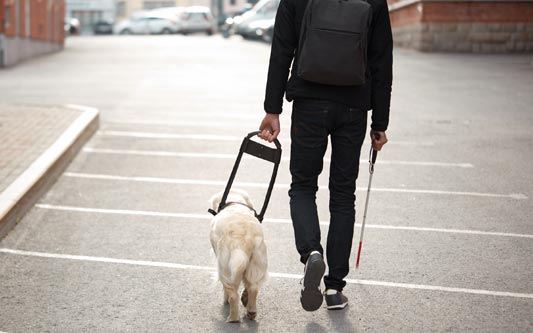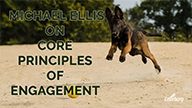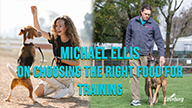Guide Dogs Know Where to Go
Ed's Note: Daniel Jacob is a writer and guide dog expert who lives in Montreal, Canada. He often writes from his perspective of being a blind man navigating the world with his guide dog.
We got to talking through email and I asked him about how his guide dog knew which building to find and how to get in. This was his response which I thought would be helpful to share on Leerburg.

Dogs don't know where to go and they're not supposed to. As a handler, we are the ones who have to always know where we're going. The dog eventually learns certain routes through repetition. But it's essential and preliminary for a handler to undergo an intensive mobility course in order to guide our dog.
As mentioned in my A Primer on Guide-Dog Etiquette article, a guide dog's four main tasks are:
- To stop at curbs or steps.
- To navigate around obstacles.
- To find landmarks such as doors or seats.
- To walk in a straight line (especially important to a person born blind).
Believe it or not, a person born blind has no concept of what a straight line is. We can, however, judge the direction in which we are walking by the sound of the traffic. Yes, this means we can and do get lost at night because there is no traffic to guide us. But part of getting a guide dog is that we are encouraged to take different routes every day to the places we need to go so that the dog doesn't go into autopilot.
This “taking different routes every day”, is not only a mobility reinforcement tool for us, but it is a bonding experience for the dog. In training, we are taught to constantly talk to our dogs, tell it jokes or stories, or memories about family outings and such to keep the dog's attention. It's funny what people believe about blind people and guide dogs. People really believe the dogs take us places. They don't. They just help us get there safely.
I never tell my dog, let's go to Provigo, (a famous food store brand here in Quebec), or let's go to Walmart, or something like that. I give him directions like turn right here or turn left there. If I know we're on the right block, then I'll say, “Find inside.” The dog will take me to the first door he sees. If it's not the right one, then we'll move on to the next, and I'll count. When we reach the right one, then he gets a treat or a mark. That's how they learn.
If we go to a new dig or there is construction, I have to ask for help. I don't have a choice, especially in a new area. The dog's not going to know a new area. He's never been there either. In a new area, the dog is going to be more stressed, and inevitably more distracted which, unfortunately for us, is when people try to interact with our dogs the most for some reason.
Also unfortunately, it is more difficult to get assistance when we have a guide dog because of this perpetual myth that the dog knows and does everything.
You can't play the piano if you've never had one, and a dog can't get you anywhere they've never been before. But these days, technology helps us tremendously. iPhone users have apps like BlindSquare which tell you what street you're on and approximately what address you're at. Maps for iPhone is also very accessible. We can guide our dogs with the help of technology.
In guide dog training school, we also use training decoys much like protection training. All creatures have the natural instinct to go around an obstacle, but dogs have to be trained to get around an obstacle for themselves and their handler, so for this we use a decoy.
For example, when approaching a trash bin, we have the decoy tab the bin. This gets the dog's attention which is kind of what we want. We stop and trail our right hand along with the dog's head to its nose, where we can feel the obstacle. Then, using bait, the decoy signals a clear path around the obstacle, and once we've cleared it, the dog gets the treat. We use the same sort of technique to not just find the door, but to find the actual door handle. A bit long-winded I suppose, but there you have it, guide dog training in a nutshell.




.jpg)



Ask Cindy.